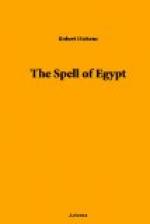I have heard travelers on the Nile speak piteously of the confusion wakened in their minds by a hurried survey of many temples, statues, monuments, and tombs. But if one stays long enough this confusion fades happily away, and one differentiates between the antique personalities of Ancient Egypt almost as easily as one differentiates between the personalities of one’s familiar friends. Among these personalities Medinet-Abu is the warrior, standing like Mentu, with the solar disk, and the two plumes erect above his head of a hawk, firmly planted at the foot of the Theban mountains, ready to repel all enemies, to beat back all assaults, strong and determined, powerful and brutally serene.
XI
THE RAMESSEUM
“This, my lord, is the thinking-place of Rameses the Great.”
So said Ibrahim Ayyad to me one morning—Ibrahim, who is almost as prolific in the abrupt creation of peers as if he were a democratic government.
I looked about me. We stood in a ruined hall with columns, architraves covered with inscriptions, segments of flat roof. Here and there traces of painting, dull-red, pale, ethereal blue—the “love-color” of Egypt, as the Egyptians often call it—still adhered to the stone. This hall, dignified, grand, but happy, was open on all sides to the sun and air. From it I could see tamarisk- and acacia-trees, and far-off shadowy mountains beyond the eastern verge of the Nile. And the trees were still as carven things in an atmosphere that was a miracle of clearness and of purity. Behind me, and near, the hard Libyan mountains gleamed in the sun. Somewhere a boy was singing; and suddenly his singing died away. And I thought of the “Lay of the Harper” which is inscribed upon the tombs of Thebes—those tombs under those gleaming mountains:
“For no one carries
away his goods with him;
Yea, no one returns
again who has gone thither.”
It took the place of the song that had died as I thought of the great king’s glory; that he had been here, and had long since passed away.
“The thinking-place of Rameses the Great!”
“Suttinly.”
“You must leave me alone here, Ibrahim.”
I watched his gold-colored robe vanish into the gold of the sun through the copper color of the columns. And I was quite alone in the “thinking-place” of Rameses. It was a brilliant day, the sky dark sapphire blue, without even the spectre of a cloud, or any airy, vaporous veil; the heat already intense in the full sunshine, but delicious if one slid into a shadow. I slid into a shadow, and sat down on a warm block of stone. And the silence flowed upon me—the silence of the Ramesseum.
Was Horbehutet, the winged disk, with crowned uroei, ever set up above this temple’s principal door to keep it from destruction? I do not know. But, if he was, he failed perfectly to fulfil his mission. And I am glad he failed. I am glad of the ruin that is here, glad that walls have crumbled or been overthrown, that columns have been cast down, and ceilings torn off from the pillars that supported them, letting in the sky. I would have nothing different in the thinking-place of Rameses.




